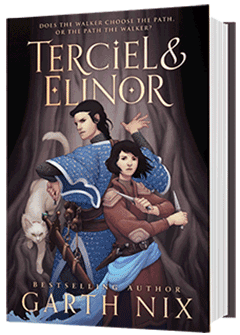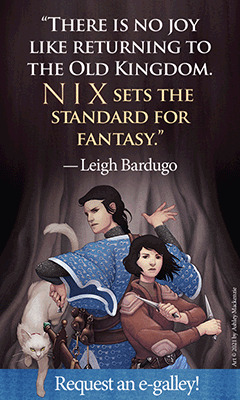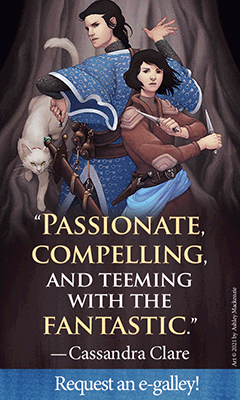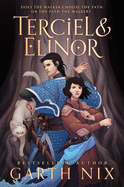Terciel & Elinor
by Garth Nix
The sixth book in Garth Nix's YA series The Old Kingdom is a gripping novel filled with dynamic characters and terrifying creatures. This prequel can act as both introduction for new readers--with its fully developed world, excellent plotting and enchanting cast--as well as a delightful return to Ancelstierre and the Old Kingdom for those already in love with the series.
When Terciel was about eight years old, an old woman calling herself his great-aunt took him from his life as an impoverished orphan and brought him to her grand house in the Old Kingdom, a land to the north filled with magic, necromancy and the Dead. Terciel, a "brown-skinned, dark-haired" boy, knew nothing of magic. Even so, when Tizanael brought him to her home, he already had the Charter mark on his forehead, a magical symbol that allows Charter Mages to identify other Charter Mages. He also had the bells: "One moment they had not been there, and then there they were... the bandolier, with the [seven] mahogany bell handles... crawling all over with glowing Charter marks." A decade later, Terciel is Tizanael's Abhorsen-in-Waiting, training to use the bells to control the Dead and keep the country safe from necromancers and Free Magic.
Nineteen-year-old Elinor Hallett also has the Charter mark on her forehead. But her mother, a distant and imposing woman, taught her that the mark is a "disfiguring scar" that was horrifyingly branded on Elinor by her own grandmother. The young woman has been kept in relative seclusion all her life, her only friends her governess, Mrs. Watkins, and Mrs. Watkins's uncle, Ham, who is "ostensibly" the manor's groom. Ham teaches Elinor the tricks of his original trade: circus performer. "Slim, strong, swift, and dexterous" Elinor excels at tumbling, swordplay and knife-throwing. Her education has been limited to the theatrical arts with Ham and those things a lady must know, taught to her by Mrs. Watkins.
It never occurs to Elinor that there might be more to the world than what she's been taught. Certainly, she has imagined leaving the manor and going on the road with the circus, but never has she thought her scar might be imbued with magic or that the woman who gave it to her was a powerful magic user herself. Elinor remains ignorant until her mother falls ill. When she falls into "a state closely resembling death" and doctors are unable to help, Elinor begins to take over the household. Quickly, she discovers that she is destitute.
As Elinor reels from this revelation, a wind blows in from the north and a young man shows up at her door. He is "tall, and thin, and strangely pale," with hair that is "black and shiny as polished ebony." She does not know that this young man is the Abhorsen-in-Waiting, nor does she know that his pale skin is a sign of his walks in Death. She also does not know that he is there to banish the Dead creature inside her mother. But when "the creature who wore her mother's body" comes after her and Terciel, with "legs... little more than bone, with strips of hanging flesh," Elinor learns there is terrible magic.
As with the previous books, history and familial lines are important in Terciel & Elinor, which gives the uninitiated plenty of new and exciting information. It also offers those in the know the great fun of making connections from this earlier time to characters they've already met. Nix's Old Kingdom is such a wholly developed world that reading the prequel as a fan of the other books feels a bit like seeing an old friend or settling into a hot bath. Elinor and Terciel are strong-willed, determined characters who act as foils to each other even as they pine for one another. Both have a goal: Terciel to become a strong, capable Abhorsen, and Elinor to figure out who she is by traveling north. Their individual expeditions bring them closer to their goals--and each other. It's a bittersweet love story, because readers of the series know that Elinor will die giving birth to their child, but that knowledge doesn't stop the relationship's development from being powerful. And more important than Terciel and Elinor getting together is their individual growth while they are apart: their travels and the many happenings along the way are exhilarating, frightening and deeply compelling. Terciel & Elinor is an excellent addition to the series, and readers will hope that Nix gives us much more of the lovers' story. --Siân Gaetano, children's and YA editor, Shelf Awareness








